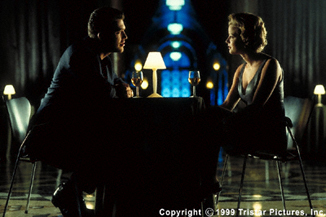
|
Hidden Gems: The 13th FloorBy Stephanie Star SmithDecember 18, 2003
Some films are overlooked because they have the misfortune of being released close on the heels of a blockbuster with some surface plot similarities. Other films are neglected because a brief synopsis gives audiences too much of a seen-it-before vibe. In the case of The Thirteenth Floor, it was a bit of both. The Thirteenth Floor was released a scant two months after a little film called The Matrix. Though both films are ruminations on reality and illusion and differentiating between the two, they take decidedly different paths to their insights. But given the phenomenon that was The Matrix, The Thirteenth Floor was overshadowed at release, to the point where reviewers in the intervening years often believe the latter film a copy of the former, although they were in production at the same time. The Thirteenth Floor’s take on the question of what is real and what is not is set at a software development firm. The company has created a revolutionary virtual-reality software that generates an environment so visceral, one can actually interact with the construct just as one would in the physical world, a process the creators call “jacking in”. Moreover, the simulation continues when a user isn’t jacked in, and each simulacrum has a consciousness within the virtual setting, an existence which is taken over temporarily when a user jacks in. Perhaps the most revolutionary aspect of the virtual-reality system is that any physical sensation that occurs while a user is jacked in carries over into reality. If a construct is injured, the user is injured. If the simulacrum dies, the user also dies. During one of his many jaunts to his favorite virtual-reality setting, a reconstructed 1937 Los Angeles, the company’s founder, Hannon Fuller, stumbles upon a secret so monumental that someone is willing to kill to keep it. Realizing his demise is nigh, Fuller leaves clues to his discovery for his right-hand man and protégé, Douglas Hall, the virtual-reality setting. Fuller is indeed murdered, and Hall becomes the prime suspect. The clues begin to pile up against him, and for his part, Hall has no memory of where he was the night Fuller died. To clear his name, Hall jacks in to Fuller’s VR world, navigating the treacherous waters of dealing with computer-generated creations that come as close to being living beings as it is possible for electronic impulses and binary information to be, and who don’t know they are, in fact, simulations. A plot synopsis for The Thirteenth Floor really doesn’t do the film justice for a number of reasons, with the primary problem being that to reveal too much about what happens spoils the film. For at its base, The Thirteenth Floor plays more as film noir than straight science fiction. There is the murder mystery, with Hall striving to clear his name. There is the secret that got Fuller killed to be discovered. And there are shadowy figures who seem to appear from nowhere, claiming to be people whose previous existence was unknown, and who may or may not be who they claim. It is the unraveling of these riddles that makes The Thirteenth Floor a riveting film, one that will keep you guessing as to what is really going on until the final reel. There are also some wonderful performances in The Thirteenth Floor, most notably Craig Bierko as Douglas Hall and Vincent D’Onofrio as Jason Whitney, a software developer and colleague of Hall’s whose 1937 alter-ego inadvertently discovers the truth about his reality, to tragic result. But aside from the plot twists, the best thing about The Thirteenth Floor are the special effects. Even given the advances in CGI in the four years since the film’s release, The Thirteenth Floor still dazzles. The process of jacking in is a light show not to be missed, and the subtle effect used to indicate when a consciousness has been co-opted by a user actually becomes of importance to the viewer wishing to play sleuth. There are also some great effects in the VR world having to do with the secret Fuller discovered that display some wonderful compositing work that looks as realistic as what you would see looking out of your window. In all, The Thirteenth Floor is a complex, compelling film that uses its gee-whiz effects in service of a very tight little mystery. It will not only keep your interest, but keep you guessing until the very last one of its 100 minutes.
|
Tuesday, December 16, 2025
© 2006 Box Office Prophets, a division of One Of Us, Inc.